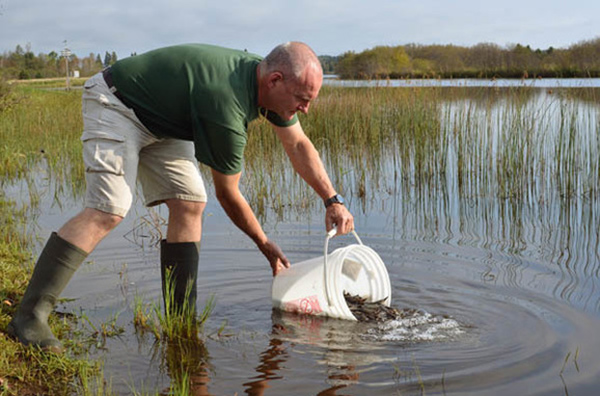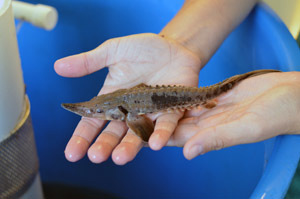By BOB GWIZDZ, MDNR
 Michigan DNR Working to Revitalize Sturgeon Population
Michigan DNR Working to Revitalize Sturgeon Population
Lake sturgeon evolutionary ancients that have lived in the Great Lakes almost forever have something in common with Michigan's salmon, which didn't even live around here until a half century ago.
Both types of fish spend most of their time in big lakes but run up rivers to spawn; and they both show surprising faithfulness to their natal streams.
Sturgeon have evolved in the Great Lakes system for so long that they are genetically different from one river to the next.
"It's possible to catch a sturgeon in Lake Michigan, genotype that sturgeon, and we can tell which river it came from," said Ed Baker, a research biologist with the MDNR.
That fact isn't lost on fisheries managers who are attempting to revitalize Great Lakes sturgeon populations.
The multiple agencies involved in the program - the Michigan DNR, Wisconsin DNR, U.S. Fish and Wildlife Service, and the Little River Band of Ottawa Indians - have concluded that rearing fish on site in the streams they are rehabilitating is preferable to distributing them from a central facility, such as the Black River Sturgeon Hatchery in Cheboygan County, which is the Great Lakes most productive sturgeon facility.
They have also found that getting the egg stock from the river in question is better, too.
There are currently eight sturgeon-rearing facilities in the Great Lakes.
In addition to Black River, these include two facilities in Wisconsin, three in Michigan's Upper Peninsula, one on the Kalamazoo River, and the one that started the movement to rear sturgeon streamside, the facility operated by the Little River Band on the Manistee River.
 Small SturgeonBegun in 2004, the Manistee River operation keeps getting better, said Corey Jerome, the fisheries biologist with the tribe.
Small SturgeonBegun in 2004, the Manistee River operation keeps getting better, said Corey Jerome, the fisheries biologist with the tribe.
"We've seen some substantial increases in our release numbers over the years," Jerome said. "We've released just over 1,200 fish from our facility and they're all PIT-tagged so we know that at least a few of them are growing and doing well out in Lake Michigan."
Passive integrated transponder, or PIT, tags identify individual fish with a code that can be read by passing a reader over the implanted tag.
"The first year we released three fish from our facility," Jerome said. The last few years have been good for us. Sturgeon is a clan animal to the tribe. It was believed that if we could bring back the sturgeon in a good way, it could help the tribal culture and community. We get a couple hundred people at the release each year, and our tribal council puts a lot of support into the project each year."
This spring, Little River Band staffers recaptured a sturgeon in Manistee Lake that had been released from the streamside facility in 2008. The fish, originally 7.3 inches long and weighing .5 pounds, had grown to 45 inches and 28 pounds.
Jerome said he believed the fish was headed upstream to spawn when it was captured.
The streamside rearing facilities are essentially cargo trailers through which river water is pumped to imprint the natal stream upon the fish.
Obtaining fish to work with is a noteworthy task. Unlike salmon, which typically die after spawning, sturgeon are long-lived creatures that spawn many times over the course of their lives. Fisheries managers prefer to not even handle them to avoid posing any potential risks to the sturgeon.
Instead, fisheries workers collect fertilized eggs or capture larval hatchlings with drift nets. They install egg mats in the streams where eggs are laid - essentially concrete blocks covered with furnace filters to which the eggs adhere so they can be gathered and hatched in the streamside rearing facility.
But not all streams have enough sturgeon in them to make egg-collecting viable.
"The Kalamazoo, Manistee and Black rivers are rebuilding populations," Baker said. "The other facilities are efforts to return sturgeon to rivers that historically had them but don't anymore. The Kalamazoo, Manistee and Black are using locally hatched fish. The other rivers are getting eggs from nearby streams."
In the Upper Peninsula, the streamside facilities on the Cedar and Whitefish River, which are tributaries to Lake Michigan, are getting their eggs from the Peshtigo River in Wisconsin. The Lake Superior facility on the Ontonagon River gets its eggs from the Sturgeon River in Baraga County.
Operating the streamside facilities is a rollercoaster ride.
Brian Gunderman, a DNR fisheries biologist who oversees the Kalamazoo River, says there are good years and bad years.
"Last year was a bad year; we only wound up with two fish," he said. "The year before that, we got off to a real good start we got 2,000 eggs, the most we've ever got - but then we had some vandalism at the trailer and we lost the majority of the eggs, and we wound up with 38. In 2011, our first year, we got more than 100 It was our best year and we released 8- or 9-inch fish. But the next year we raised none."
The DNR has built a spawning riffle - which is a rough-bottomed, shallow section of rippling stream where fish lay their eggs - on the Kalamazoo to attract fish to a historic spawning site, but last year few adults showed up, Gunderman said.
Sturgeon spawn in moving water over rocky river bottom in late April or early May, and the young are reared in the facility until August. Survival is good if the young sturgeon are 6 inches or longer when they are released. All are implanted with PIT tags so they can be monitored.
Baker said the ultimate goal is to restore lake sturgeon, recovering their population, so they can be removed from the threatened species list, and to then hopefully develop recreational fishing opportunities over time.


